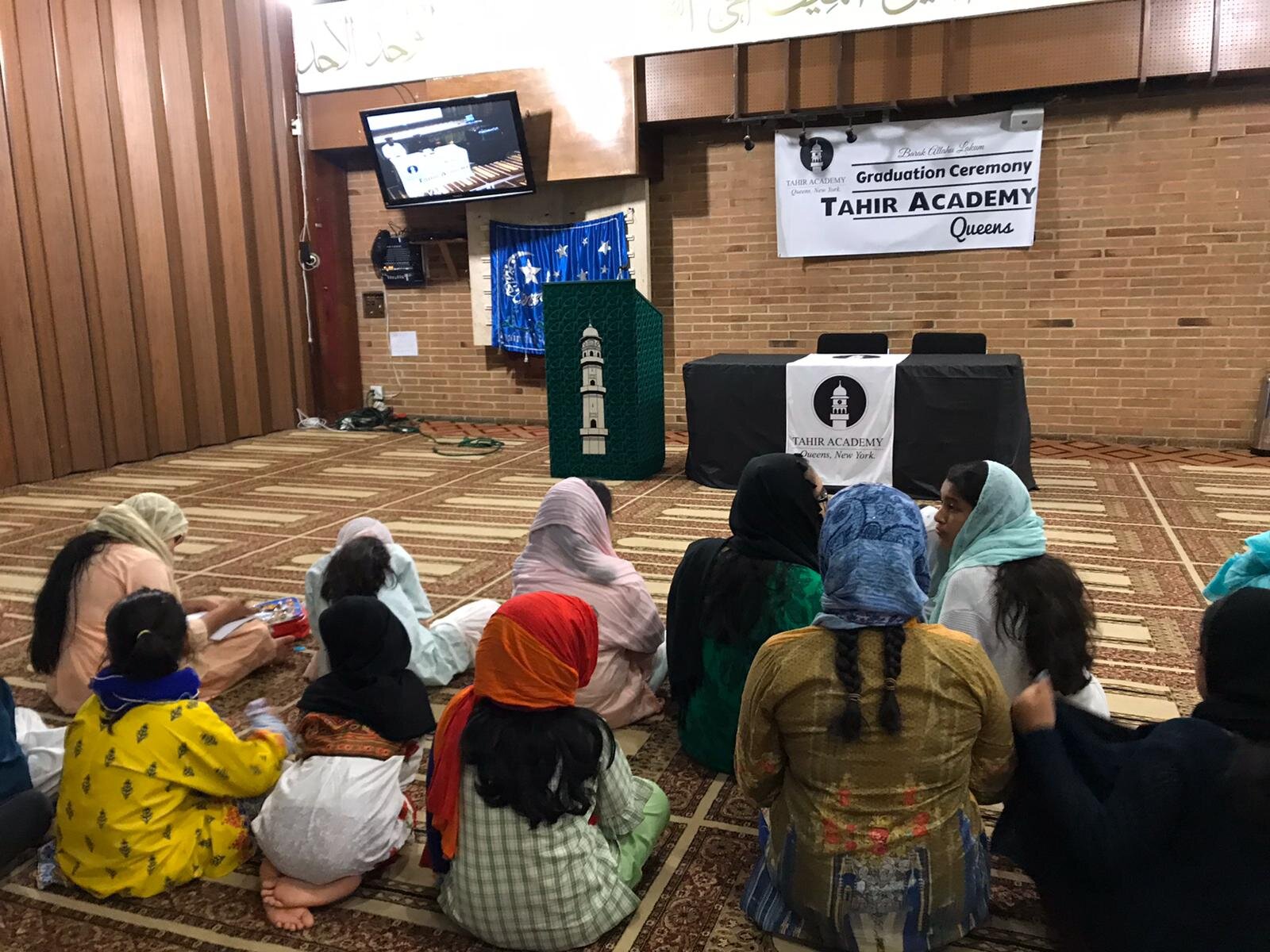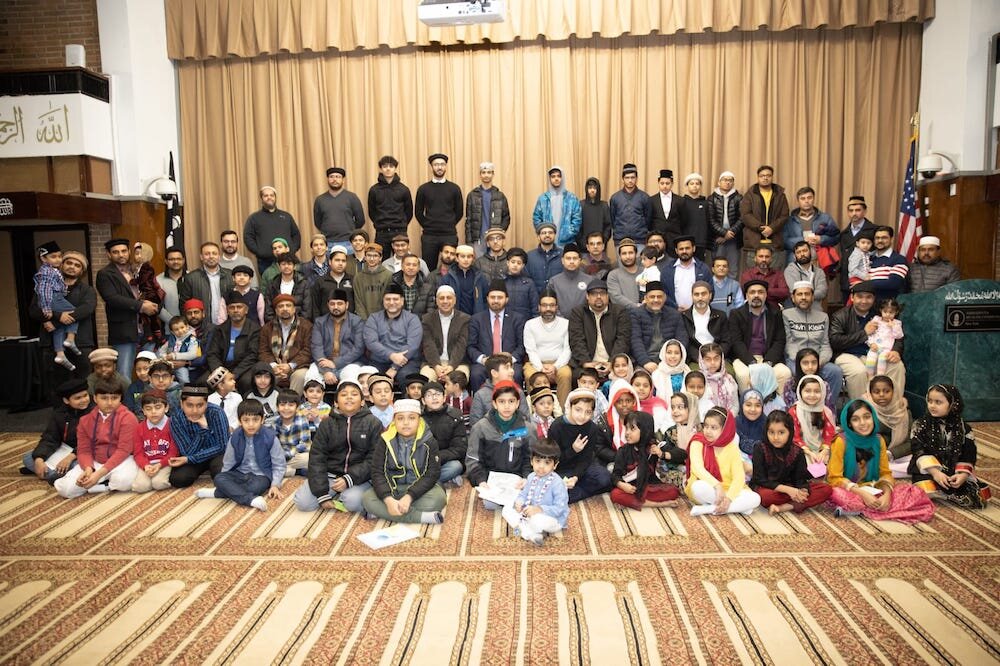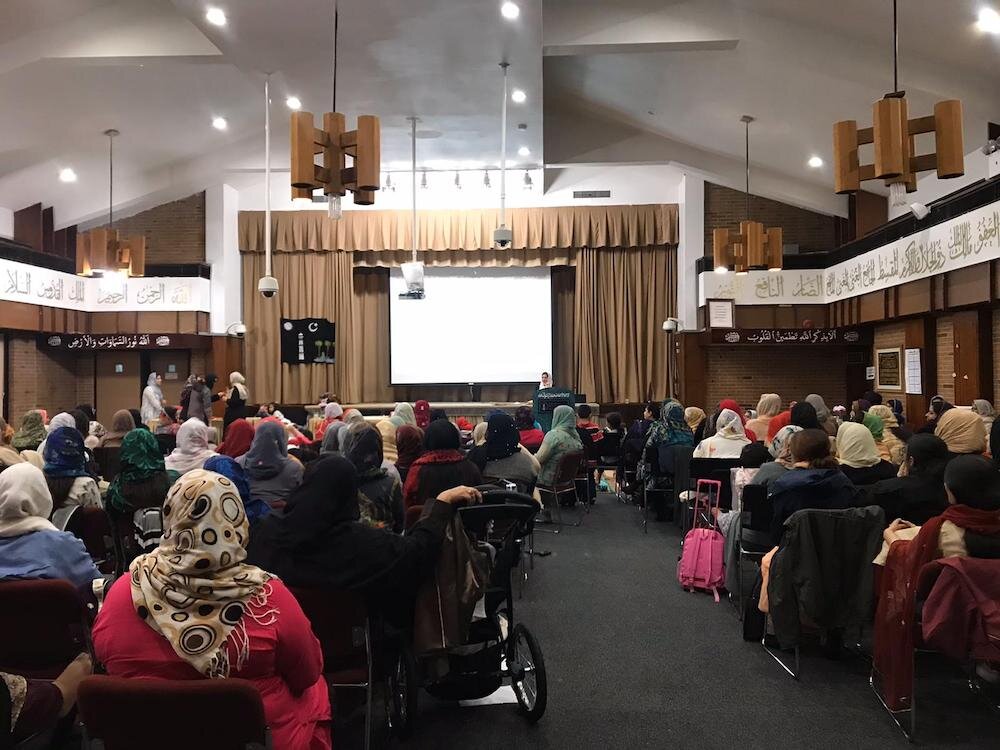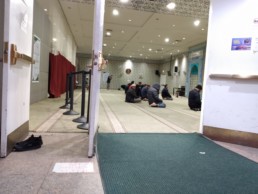Pledging Your Life to Allah, the Ahmadi Way
As published in Religion Unplugged
Pledging Your Life to Allah, the Ahmadi Way
Neha Mehrotra | nm3148@columbia.edu

NEW YORK— Suman Amara Ahmad has always known that her future was not hers to chart. But she doesn’t mind. She has made her peace with it. That, she says, is the fate of being a waqf-e-nau. You have no idea where you will land up. “I could be sent anywhere in the world,” she says. “It’s all up to the Khalifa.”
On a recent Saturday morning before the coronavirus lockdown, Amara was one among approximately 50 waqf-e-nau children who gathered at Bait-uz-Zafar, an Ahmadi mosque in Queens, New York. In Arabic, “waqf” means to pledge and “nau” means new.

The waqf-e-nau journey begins in the womb, when pregnant mothers offer their unborn child to Allah. This is not a metaphorical pledge but an actual one. When parents decide on rearing their child as a waqf-e-nau, they write a letter to their Khalifa (supreme leader) surrendering their child to the supreme leader, to assign them a societal role as he sees fit. This waqf-e-nau ijtema (gathering) was a biannual test of all the children pledged by this ritual, to measure their progress and reward excellence.
At 22 years old, Amara is too old to take part in the test, which is meant for children ages 8 to 15. But having gone through the same process when she was younger, she is familiar with its ins and outs and is here to help. The children themselves look excessively washed and combed and a little nervous. They have reason to be. At today’s ijtema, they will be tested on six standards: 1) Religious knowledge and etiquette 2) Hadith, sayings of the Prophet Muhammad 3) Quran 4) Salaat, the liturgy of prayer to follow five times a day 5) Nazm, a genre of Urdu poetry and 6) Prayer that is voluntary and not part of salaat. The pledges are marked for their performance in each category and, after a grand totaling, the highest scorers will be awarded prizes.

This practice is unique to a particular sect of Islam called the Ahmadiyyas. Though Sunnis and Shias are the two major sects of Islam, the religion has a number of offshoots, each with its own variations in belief and practice. Historically, Ahmadis have stood apart from mainstream Islam. While traditional Muslims believe that there is one God and Prophet Muhammad is the last prophet of God, Ahmadis believe Mirza Ghulam Ahmad (1835-1908), who founded the Ahmadi movement, was sent to renew the Prophet Muhammad’s message. Ahmadis do not propose a “return of the prophet” but rather consider Ghulam Ahmad to be the Messiah invoked in the Quran who is destined to come and renew the prophet’s message. The Ahmadiyya Muslim community teaches that God sent Ghulam Ahmad as a metaphorical second coming of Jesus Christ to end religious wars, condemn violence and restore morality, justice and peace.

Due to this difference of perspective, a large section of Muslims consider Ahmadis heretics and refuse to acknowledge them as Muslim. In response, the Ahmadis have largely cut themselves off from mainstream Islam. Though Ahmadis engage in missionary work in the communities they are a part of, their main focus is on consolidating strong cross-continental networks within their own community. The waqf-e-nau is an extension of this.
“We think waqf-e-nau children are special because they are going above and beyond to fulfill the responsibilities of an Ahmadi Muslim,” says Farah Ahmad, a mother who has pledged all three of her children to be waqf-e-nau, all of whom are participating in the day’s test: two sons, ages 13 and 8, and a daughter age 9.
Since the initial pledge is made before the actual birth, the child has no say in the matter, at least until the age of 15. From birth till their 15th birthday, waqf-e-nau children, like Amara, are given a special education. Every weekend, when most children are kicking back after a week of school, the waqf-e-nau attend Saturday training at the masjid, learning the finer points of their religion. Once they turn 15, the children are asked to renew the pledge made by their parents.
At this point, they could potentially demur and decide against continuing to be a waqf-e-nau. “But that’s rare. Once parents have committed, most children see it all the way through,” says Ahmad. None of her three children have reached the age of 15 yet, but Ahmad is confident that all her children will renew their pledge when the time comes. The first renewal is followed by a second renewal at 18, and a third one at 21. In this ultimate pledge, the Khalifa meets with the child, and based on the child’s chosen profession, assigns him to that part of the world where he will be most useful to society. The child in turn has to obey and go where the Khalifa instructs him.
The murabbi of the Bait-uz-Zafar mosque, Mahmood Kauser, whose job involves providing religious training and proselytization, explained the reason for this seemingly strange practice:
“Giving up one’s life to God is freedom. Let me elaborate. If I wave a ball at a dog, he will go fetch it. His eyes are glued to the ball. Is this dog free? No. Similarly, if one is bound by the wants and desires of this world, one is hardly free. Waqf-e-nau are pledged and brought up with one goal: to be free of all worldly desires. Their sole purpose is to be beneficial to mankind.”
One mother claimed that she was asked to pledge her child in a dream. “When I was in college, I dreamt that I was in the OR and my mom and sister were standing around me,” she said. “As I was lying there, my baby was brought to me wrapped in red cloth. On the cloth, it said in clear letters ‘waqf-e-nau.’”
Another mother said that everything she has belongs to Allah and her own child is no exception. “A child is a gift from Allah and so absolutely belongs to Allah first.”

Amara’s mother followed a similar reasoning when she first pledged Amara as a waf-e-nau. It’s been 22 years since then. Amara is currently in her second year of studying medicine, with no inkling of what her future will look like.
“As of now, medical students are being sent to Guatemala because they are most needed there,” she says. “But when I met the Khalifa last year, he told me that he won’t send me there. He is going to send me somewhere else. Let’s see.”
She glances around the room at the 8-12-year-olds demonstrating their knowledge of everything from the rules of Islamic dining to poems espousing the spirituality of Islam. Her eyes are warm and aglow. Perhaps she sees herself in these children, all of them bound to Allah, their futures lingering in the air, suspended, uncertain.
Honoring Babalú-Ayé and Oshun
Honoring Babalú-Ayé and Oshun
Esohe Osabuohien | eco2132@columbia.edu

Spiritual incantations dedicated to Yoruba gods fill the room as 16 adults, 15 women and one man, file into the second-floor studio of the Cumbe Center for African and Diaspora Dance located on Fulton street in Brooklyn. Today’s incantations are dedicated to the Orisha Elegua -- deity of the crossroads, destiny and fate. The dance instructor, Tony “Yemaya” Domenech, shouts over the clamor to let everyone know that they should find a place on the floor and start stretching. There is no time to waste for today’s lesson as the students would be learning the movements for two Orishas, Babalú-Ayé and Oshun.
In the Yoruba tradition, Elegua serves as the gatekeeper between the physical world and the spiritual. Having the students warm up to his incantation creates an open pathway of communication with the other Orishas. Additionally, Domenech, the instructor, carries the title of Yemaya signifying that he is a son of the Yoruba deity, Yemaya, goddess of salt water, mother of all living things, and guardian of mother and children.
Once the students have found their space on the floor, Domenech introduces himself and informs the students that he prefers a high energy classroom and that his methods function on call and response. The students shout a collective, “yes!” and the lesson begins.
Domenech starts the class by explaining the basic steps for all Orisha dances, “everything is flatfooted, knees bent, and shoulders back moving from the pelvis,” he explains. He goes on to say that feet are the foundation for everything, and a firm, flatfooted stance is important for building the base of the dances. A flatfooted stance is also important because the movements are heavily rooted in a west African dance tradition. The students shout their “yeses” in acknowledgement that they understand.
“No one is going to be mounted, we’re just focusing on the dance,” Domenech said while preparing to teach the first step. To be mounted by an Orisha, in the same way of mounting a horse, is to be possessed and embody the Orisha. He explains that this is an exercise in dance and not in ritual. You don’t have to be a follower of the religion to learn the dance.
One of the benefits of non-practitioners of the Yoruba tradition learning how to perform the movements is that they can participate if invited to a Yoruba event, he adds.
Domenech turns up the music, and praise to Elegua, then Babalú-Ayé, fills the room. The students seem very eager to learn the moves and get them down:
Step 1: Center your body towards the three batá drums. The batá drum is a double-headed percussion instrument, used predominantly for religious ceremonies. There are 23 standard rhythms for the Orishas, and when performed a certain way can summon them.
Step 2: Learning the “V steps,” a move that adds an element of Christianity to the Yoruba practice. The V steps movements are performed in the shape of a cross – step forward (the Father), step backwards (the Son), step to the left and then to the right (for the Holy Spirit). These steps are more aggressive, and done during the performances for Shango, Oshun, and Oba; the feet are planted and meet with each beat of the batá drum. Domenech stresses this to the students, a predominantly female class with one male, as he sees them beginning to mimic his movements.
“It should be playful, but not cute,” said Domenech.
With the first steps down, Domenech pauses the class to tell the students the story of the gods they are dancing for.
Babalú-Ayé, also known as Saint Lazarus in Catholicism, is the “Father, lord of the Earth,” overseeing infectious diseases and health. The story of Babalú-Ayé, as told by Domenech, is that he was a lady’s man who went to see the Orisha, Orunmila, for divination. Orunmila counseled Babalú-Ayé to abstain from women for a while, but Babalú-Ayé disobeyed him after becoming smitten by a new woman. As a result, he was cursed with leprosy and banished from his kingdom.
When performing for Babalú-Ayé, he appears as a “crippled man” who carries a cane. Therefore, his dance moves are deep with hard dips and rolling shoulders. As Domenech finishes the story of Babalú-Ayé, the women in his class try the dance moves, but Domenech has to instruct them to make the steps “uglier.” They should look like they’ve lost everything.
Blessed are the Top 10
Blessed are the Top 10
Kelly Davis | kwd2111@columbia.edu

It’s Oscar Sunday, and in a Gothic-style church in the Riverdale neighborhood of the Bronx, people of all ages and races sit patiently in the quiet sanctuary. Reverend Krystin Granberg rests her arms comfortably on the pulpit as she begins her sermon for the 10:30 a.m. service at Riverdale Presbyterian Church, located at 4765 Henry Hudson Parkway. Her topic is not a Bible verse. Her message is not fire and brimstone.
“I love Oscar Sunday even more than Super bowl Sunday,” Granberg begins. Church-goers respond with a chuckle and the solemn faces in the room seem to be at ease a little bit.
Much to my surprise, Granberg’s message is centered around today’s pop culture. She speaks about the trend of “top 10” lists.
Top 10 movies of 2019
Top 10 vegan restaurants in NYC
Top 10 ways to get fit in the new year
But religion isn’t far behind. “Jesus has a top 10 list, too,” she remarks.
She proceeds to introduce a familiar passage from the bible most commonly known as the beatitudes.
“Blessed are the poor in spirit, for theirs is the kingdom of heaven.”
“Blessed are those who mourn, for they will be comforted.”
“Blessed are the meek, for they shall inherit the earth.”
Matthew 5: 3-5
She compares the beatitudes with the to do lists that modern-day culture sets for us to be successful. Granberg explains that the bible verses and other similar scriptural references are not the top 10 lists like the world gives us, but rather a list of things that have already been done.
When Jesus recites the beatitudes, he is not saying what believers must do in order to be good Christians. Rather, he is explaining what the kingdom of God presents, as gifts, to those who believe in Him and his message of salvation.
Tying her message back to the Oscars, she recalls one of her favorite movies, “Monty Python’s Life of Brian.” While the movie offered her powerful lessons that she still holds today, Brian, the farcical main character, was just as persecuted as Jesus was for spreading the message of salvation. Brian’s struggles in various scenes of the movie reflect Jesus’ own challenges.
Granberg reminds the congregation that they should not ask God what to do to be worthy of His love, instead to know that any shackles of anxiety, fear, depression and worry have already been broken. The kingdom God is about being rather than doing, she says. We are already blessed, and there is nothing more that we need to do to be approved. She adds that the only thing the Lord requires of us is to, in the words of the Prophet Isaiah, do justice, love kindness and walk humbly with the Lord.
She also says that if she had the chance, she would write additional beatitudes and include things like:
Blessed are the truthtellers
Blessed are the caretakers
Blessed are the peacemakers
And above them all: Blessed are the rulebreakers, who advocate for the most destitute of society.
She says that she was perplexed that so many people are confused with what others are not doing. This creates a culture of people that are so anxious about what they are or not doing, they end up projecting their feelings of failure onto others. Referring back to the to do list, Granberg points out that church gives everyone an opportunity to be critical.
As the sermon wears on, she goes back to the phrase of what the bible requires of us: to do justice, love kindness and walk humbly with the Lord. She cites biblical figures that ministered to lepers and preached to them about the love of God.
Closing her sermon, Granberg says that in trying to make a difference in this world, we can start by impacting each and every person we meet. She pleads that in this world of chaos and turmoil, her congregation preaches cheerfulness and radical love.
Job and the Super Bowl
Job and the Super Bowl
Zoé Chevalier | zc2504@columbia.edu

Fewer congregants come to Bible study on Wednesdays than on Sundays at the United Pentecostal Church in Harlem. But it is no less spirited. On a recent Wednesday, seven worshippers sit in the prayer room in front of Pastor Michael Granttan. Despite his whitening hair, Grattan is an energetic man, often jumping to his feet to illustrate a lesson. He is dressed in casual clothes: A knitted sweater and pants have replaced the suit of Sunday’s service.
Grattan’s teaching style is a combination of Bible verse study, personal anecdotes, sports references and modern-day cultural applications. During the first part of the lesson, people in the audience are encouraged to ask all the questions they want, both Biblical and personal.
A young woman, whom I recognize as one of the singers of Sunday’s service, starts off by asking, “How do we know if the hardship we have been given comes from God?”
She proceeds to tell the tale of a family member who had been diagnosed with breast cancer and refused treatment, waiting for God to cure her. One day, she went to a naturopathic doctor who gave her an ointment to put on her breast. This, she said, led to an emergency mastectomy. The woman found out that during the year and a half that she had not been given treatment, the tumor had not metastasized. She praised God for protecting her. Her husband, however, blamed her for losing faith and getting the surgery, saying that God was not done curing her.
Hearing this story, Grattan stands, raises his arms and starts preaching the story of Job from the Book of Job, which is part of the Old Testament.
“Job’s animals were kidnapped!
The house fell over his children!
And then he got sick! And we know there is nothing more personal than disease. There was puss coming out of his body, it was truly horrible, but he never stopped praising the Lord.”
Grattan then uses one of his favorite sports allegories to illustrate his message: “Job was hit so hard, like in a boxing ring, poom the boxer, he got a hit with a right fist then a left fist, then he got a full-body blow!” Mimicking the scene he throws his fists in the air, punching an invisible Job.
Soon, he sits back down, saying, “We know that God gave him those hardships, but generally speaking, there are no parameters that define whether or not a hardship comes from God, we create a lot of our own problems, but we need to continue to praise God no matter what.”
He adds that he believes in going to the doctor, because “God can cure you anywhere, on the operating table as well as in your kitchen, so let him cure you though your doctor.” With a deep sigh, he concludes: “I understand, as you know sister Grattan died recently.” The crowd goes silent. Everyone knows about the recent death of the pastor’s wife to cancer.
During the second half of the session, Grattan doesn’t shy away from getting into contemporary pop-culture discussions. He comments on the Superbowl half-time show, featuring Shakira and Jenifer Lopez, saying, “I don’t understand all the fuss about the fact that it was not family-friendly.” When someone brings up that Jennifer Lopez might have been mocking the sign of cross, he defends her. “No! She was simply pole dancing!”
Grattan often tries to tone down more conservative branches of the church. “I believe in balance. God is not stupid, only human beings are. Be careful about turning principles into law.” When someone in the church asks if women are allowed to wear pants, he says of course. “And what about swimsuits?” asks a man. “Is it true we are not allowed to go to the beach or swimming pool even on a hot day?” Another woman laughs. “I go to the beach!” she says. Grattan ends the discussion saying, “Yes you can. I also believe that there are apostolic swimsuits that are more modest.”
At the end of the study session, Grattan gets more serious, and passes around a sheet of paper: “A brief look at the errors of the doctrine of the Trinity.” The document is filled with typos as the pastor has “whipped it out” quickly this afternoon. Once again, Grattan stands up, agitated.
“99 out of a 100 times, 999 out of 1000 times..”
His voice grows louder.
“9999 out of 10000, and I could keep going… people turn to Genesis 1:26 to justify that God is plural.”
Genesis 1:26 is part of the Old Testament and says: Then God said, “Let us make mankind in our image, in our likeness, so that they may rule over the fish in the sea and the birds in the sky, over the livestock and all the wild animals,[a] and over all the creatures that move along the ground.”
Everyone pulls out their phones to look up the verse, and the pastor continues. “Scholars understand that this is not what this verse means, the clergy understands, but no one is teaching laypeople!” According to the Pentecostal Church, God, Jesus and the Holy Spirit are all part of the same entity, not separate beings. He sits back down: “Do you understand?”
A woman in the back raises her hand shyly. “I think that it will make sense once I really go through the scripture,” she says.
“Yes, you need to keep asking questions and work hard, I can’t give you understanding,” Grattan concludes. As the clock strikes 9 p.m., all rise and pray together.
Of Prophets and Messengers
Of Prophets and Messengers
Neha Mehrotra | nm3148@columbia.edu

At times, the class at the Islamic Cultural Center of New York felt like elementary school. The imam would start off in a sing-song manner only to pause right before the end; at this point, he would linger expectantly, waiting for the congregants to finish his sentence.
“The relation between Abraham and Ismail is….” he would begin.
“Son,” the congregants would resound.
“From Ismail came the Muslims and from Jesus …?”
“Christians.”
The entire exchange is a tennis match, the ball being thrown to and fro, with participation from both sides. And though this equality ensures inclusivity, it also strikes one as infantilizing, transforming the imam into a paternal figure and the participants into children. Perhaps that is part of the appeal.
It is Saturday evening at the cultural center, located on Manhattan’s East Side, at 96th Street and Third Avenue. Between the Maghrib and Isha prayers, Imam Saad Jalloh leads the weekly teaching, known as Dars. Saturday’s Dars focuses on Fiqh, i.e., Islamic jurisprudence. Fiqh classes explore sharia, or divine law, as revealed in the Quran and Sunnah (teachings of Prophet Muhammad). Today, the emphasis is on Allah’s prophets and messengers: the difference between them, their rank and hierarchy relative to each other, the source of their knowledge, and finally, the teaching that they imparted.
A religious and cultural institution “serving the neighbouring Muslim community of Manhattan in particular and entire Muslim community of America in general,” the Islamic Cultural Center was established in the 1960s by Muslim ambassadors from Saudi Arabia, Libya and Malaysia among others. Jalloh, himself, comes from Sierra Leone. In today’s sermon, he starts off simple, highlighting the basic characteristics that comprise prophets and messengers. “Allah placed 120,000 prophets and messengers here on Earth. He made sure that they had the best message, best family lineage, made them very good looking, with the best characteristics and best behavior. They were the best among all human beings.”
During the sermon, the imam speaks in Arabic and then repeats his words in broken English. This seems catered to accommodate the diversity of Muslims who frequent the mosque: from lifetime New Yorkers, to migrants from the Middle East, to South Asian Muslims, all of whom pray side by side in this giant prayer hall. Not everyone, however, is afforded unbridled access to the entire space. In keeping with the rules in mosques all around the world, men and women sit, and pray, separately. During this sermon too, the imam and approximately 50 male congregants sit in the main prayer hall out front. Two women and I sit at the back, separated from the main hall by a thick curtain. We cannot see the imam, and we definitely cannot respond to the periodic questions he throws out to his audience.
The imam goes on to make a somewhat confusing comparison between messengers and prophets. “Messengers will come and spread God’s message. Prophets will revive this message. So every messenger is a prophet but every prophet is not a messenger,” he says. He doesn’t stop there. He explains that even within the ranks of the messengers and prophets, there are degrees of superiority. “Some are higher ranking than others. We prefer some messengers over others. We consider some better than others.”
However, as if catching himself in time, the imam continues: “But that doesn’t mean they are unequal. Regardless of rank, all prophets and messengers are commissioned by the same God with the same message. They worship the one God, Allah. All is One. The prophets may have different levels of expertise, different geographical spheres of influence, different miracles. But these are just different approaches that all converge into the same goal. All is One.”
Jalloh seems caught in a precarious balance: between the qualitative differences in the messengers of God, and the underlying unity of their message. He is effectively walking the tightrope between inequity and equality, trying to highlight one without letting go of the other.
He ends the sermon with something like a warning: “Prophethood is a blessing that Allah grants to whoever he wishes. It’s not something you can work hard at until you get it. No one can achieve prophethood by working hard. No one can reach prophethood by garnering knowledge. It’s all up to Allah. Prophethood is a direct appointment from Allah. He decides and he has the final say.”
Jalloh’s last words are decisive; not like his lingering half-sentences of earlier, where he waited for congregants to finish his thought. In this case, Imam Jalloh, like Allah, has the final say.





